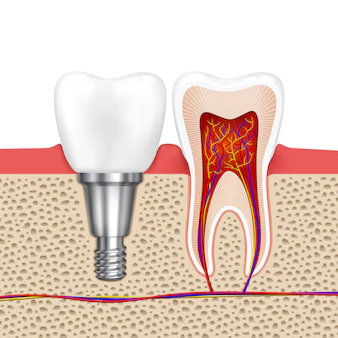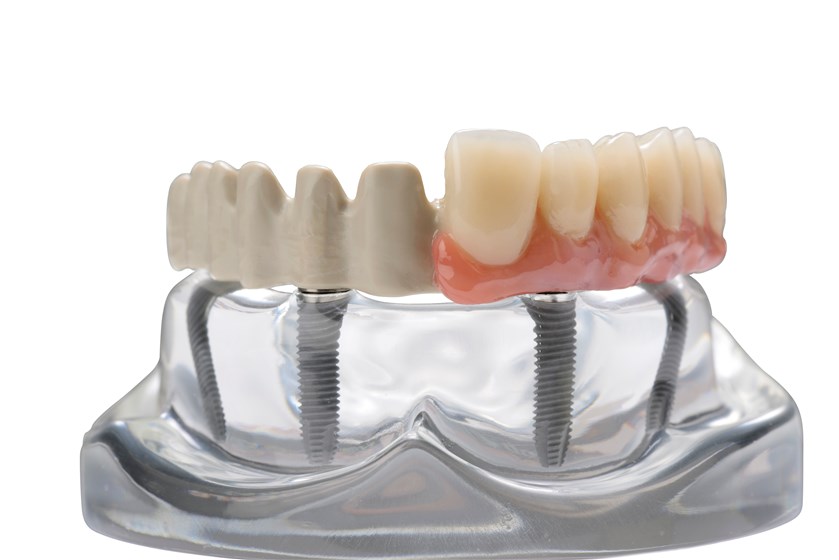After you’ve had a tooth removed due to decay or irreparable damage, there are many ways to proceed with the space left behind. One of the most common and quickest procedures is placing a dental implant. A dental implant can be placed during one appointment, typically taking about an hour total. The process for placing an implant in missing teeth varies depending on your needs and the clinic where you choose to have the procedure done. Implant placement is not a complicated process. Your periodontist will perform certain tests to determine if an implant is right for you and what type of implant will work best for your anatomy in that specific situation. If you get an affirmative response to these queries, then we move forward with a surgical plan that has general steps listed below:
Confirm the location of the tooth implant.
The first step is to confirm the location of the implant. This means putting the implant in the correct spot and making sure it is placed in the right direction so that it heals upright and stable rather than sideways or tilted. This is usually done with a special kind of dental drill that creates a small crater in the bone where the implant will be placed.

This allows the dentist to check that the implant is positioned correctly before it is placed and prevents the dentist from having to make unnecessary corrections after the implant is placed. During this process, the dentist will also take a small sample of bone in order to send it to a lab to determine whether the patient’s body will accept the implant. This is called a “bone biopsy”, and it is a quick and painless procedure.
Purpose of a dental implant with tooth
A dental implant can replace one or more permanent teeth lost to an injury, gum disease, tooth decay, or infection. When you talk with your dentist at the initial consultation, they may discuss other options for replacing the teeth as well. These may include dentures and bridges. They’ll discuss with you whether you have enough space and bone in the area of the missing tooth for the procedure. If your tooth has been missing for a while, you may have bone loss. This requires a bone graft before you are able to proceed with dental implant surgery.
Prepare the location for placing the implant.
Next, the dentist will prepare the location for the implant. That means removing any unnecessary tissues, like a portion of the gums or bone. Gum tissues are typically removed during implant placement when the dentist finds that the gums are too tight to allow the implant to be placed in the bone. When this happens, the dentist will either remove some of the gum tissues around the implant area or remove the gums completely, depending on the situation.

This is called “de-ginging” or “de-scaling”. After removing the necessary gum tissues, the dentist will determine whether any bone needs to be removed. This typically happens when the dentist finds that the jawbone is too thick, which is called “osteotomy“. However, it’s not always necessary to remove the bone.
Implant placement and wrapping with a bandage.
After completing the necessary preparations, the dentist will place the implant in the prepared location. The implant is placed using a special dental tool that helps guide the implant into the prepared space. Implant placement takes only a few seconds. After the implant is placed, the dentist will use a special tool to “pack” the implant with a small amount of bone and blood.
This helps ensure that the implant is completely seated, and it helps promote healing. Before the patient leaves the surgery, the dentist will wrap the implant site with a small bandage. The bandage will stay in place for a week or so. During this time, it is important to avoid chewing on the side of the mouth where the implant was placed.
Aftercare and recovery after placing a tooth implant.
After placing the implant, the patient will be asked to avoid eating anything hard and to avoid applying too much pressure to the jaw. This will allow the implant to heal properly and not move out of place. After one week, the patient can go back to eating the same way they did before the implant was placed. However, it will take another 6-12 months before the implant is fully integrated and ready for its final restoration. During this time, the patient will need to follow up with the dentist to make sure the healing is progressing as expected.
Why re-implantation surgery is necessary?
There are a few reasons why re-implantation surgery may be necessary. One reason is if the healing isn’t progressing properly. There could be infections or complications that make it impossible to proceed with the surgery. Other reasons could include issues with the bone quality, like insufficient bone integrity for the implant to adhere to. In some instances, the dentist may find that the implant was placed in the wrong spot. This can happen for various reasons, like the inability to fully evaluate bone quality during the procedure or the use of outdated X-ray equipment.
Conclusion
The dental implant is a procedure that can restore any tooth loss and make you feel confident again. The most important thing to do is find a dentist that you trust and feel comfortable with. If you do, you will be on your way to a brand new smile! Keep in mind that while implants can be used to replace any missing teeth, they are not right for everyone. The best way to find out if an implant is right for you is to talk to your dentist.






